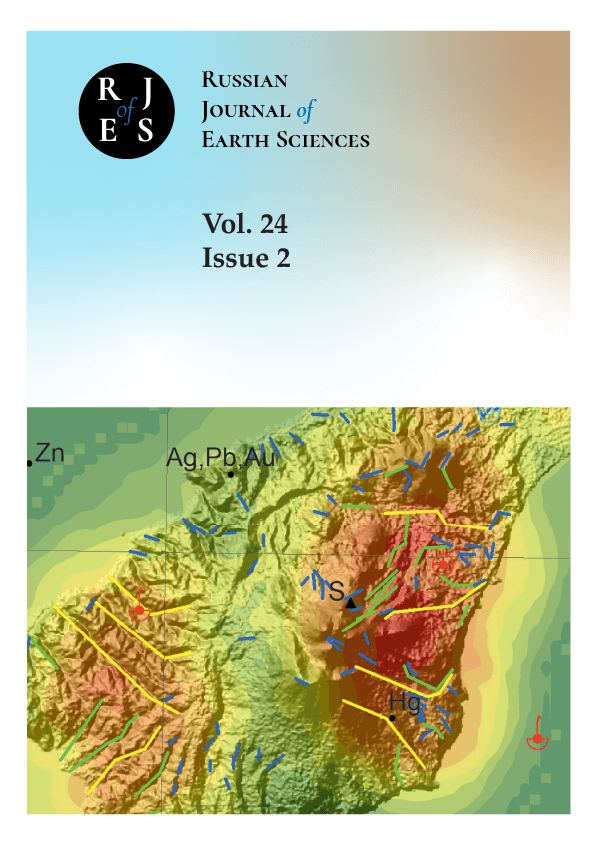Moscow, Moscow, Russian Federation
UDC 55
UDC 550.34
UDC 550.383
CSCSTI 37.01
CSCSTI 37.15
CSCSTI 37.25
CSCSTI 37.31
CSCSTI 38.01
CSCSTI 36.00
CSCSTI 37.00
CSCSTI 38.00
CSCSTI 39.00
CSCSTI 52.00
Russian Classification of Professions by Education 05.00.00
Russian Library and Bibliographic Classification 26
Russian Trade and Bibliographic Classification 63
BISAC SCI SCIENCE
It is shown that during reversals in geodynamo models the minimum amplitudes of the dipole, quadrupole and octupole coincide. Since the characteristic time of the reversal is close to the oscillations of the large-scale geomagnetic field, a similar analysis was carried out for the minima of the amplitude of the dipole magnetic field over the past 100 thousand years. It turned out that in this case such synchronization also occurs. It can be assumed that reversals and large scale variations of the geomagnetic field between the reversals have a lot in common. The wavelet analysis carried out indicates that the concept of the main geodynamo cycle is very arbitrary: the period of oscillation can vary from 8–10 thousand years to 20–30 thousand for a dipole. Analysis of the evolution of the Mauersberger spectrum allows us to conclude that magnetic field fluctuations observed at the Earth’s surface are associated with the transfer of the magnetic field to the surface of the liquid core and can hardly be described by functions periodic in time.
geodynamo, core-mantle boundary, magnetic field modes synchronization
1. Bonhommet, N., and J. Zähringer (1969), Paleomagnetism and potassium argon age determinations of the Laschamp geomagnetic polarity event, Earth and Planetary Science Letters, 6(1), 43–46, https://doi.org/10.1016/0012-821X(69)90159-9.
2. Christensen, U., P. Olson, and G. A. Glatzmaier (1999), Numerical modelling of the geodynamo: a systematic parameter study, Geophysical Journal International, 138(2), 393–409, https://doi.org/10.1046/j.1365-246x.1999.00886.x.
3. Christensen, U. R., and J. Aubert (2006), Scaling properties of convection-driven dynamos in rotating spherical shells and application to planetary magnetic fields, Geophysical Journal International, 166(1), 97–114, https://doi.org/10.1111/j.1365-246x.2006.03009.x.
4. Hulot, G., and J. L. Le Mouël (1994), A statistical approach to the Earth’s main magnetic field, Physics of the Earth and Planetary Interiors, 82(3–4), 167–183, https://doi.org/10.1016/0031-9201(94)90070-1.
5. Krause, F., and K.-H. Rädler (1980), Mean-field magnetohydrodynamics anddynamo theory, Akademie-Verlag, Berlin.
6. Liu, J., N. R. Nowaczyk, S. Panovska, M. Korte, and H. W. Arz (2020), The Norwegian-Greenland Sea, the Laschamps, and the Mono Lake Excursions Recorded in a Black Sea Sedimentary Sequence Spanning From 68.9 to 14.5 ka, Journal of Geophysical Research: Solid Earth, 125(8), https://doi.org/10.1029/2019jb019225.
7. Lowes, F. J. (1974), Spatial Power Spectrum of the Main Geomagnetic Field, and Extrapolation to the Core, Geophysical Journal International, 36(3), 717–730, https://doi.org/10.1111/j.1365-246x.1974.tb00622.x.
8. Panovska, S., C. G. Constable, and M. Korte (2018), Extending Global Continuous Geomagnetic Field Reconstructions on Timescales Beyond Human Civilization, Geochemistry, Geophysics, Geosystems, 19(12), 4757–4772, https://doi.org/10.1029/2018gc007966.
9. Reshetnyak, M. Y. (2017), Tuning of the mean-field geodynamo model, Izvestiya, Physics of the Solid Earth, 53(4), 581–587, https://doi.org/10.1134/S1069351317030090. EDN: https://elibrary.ru/XNVVDV
10. Reshetnyak, M. Y. (2021), Reversals of the Geomagnetic Field: Constraint on Convection Intensity in the Earth’s Core, Geomagnetism and Aeronomy, 61(2), 266–271, https://doi.org/10.1134/S0016793221020134. EDN: https://elibrary.ru/BGVVRF
11. Valet, J.-P. (2003), Time variations in geomagnetic intensity, Reviews of Geophysics, 41(1), https://doi.org/10.1029/2001RG000104. EDN: https://elibrary.ru/LYZPEP
12. Valet, J.-P., L. Meynadier, and Y. Guyodo (2005), Geomagnetic dipole strength and reversal rate over the past two million years, Nature, 435(7043), 802–805, https://doi.org/10.1038/nature03674.
13. Wicht, J. (2002), Inner-core conductivity in numerical dynamo simulations, Physics of the Earth and Planetary Interiors, 132(4), 281–302, https://doi.org/10.1016/s0031-9201(02)00078-x. EDN: https://elibrary.ru/BBFHFZ
















